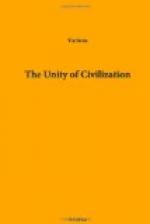This romance poetry is indeed strange, so strange that no one has yet succeeded in finding or explaining its real origin. Only the day before, the great artists were singing the gallant deeds of men, but now they can see nothing, think of nothing but the human heart. And what is perhaps strangest of all, this great reality of feeling, of passion, is presented under the form of a world almost wholly unreal and conventional. The men and women of the epic were great heroic figures, of larger stature, of greater passions than the common run, but they were quite real people, moving and acting in the real world. The figures of romance are for the most part, but for the intense reality of their love, the unreal, conventional figures of a world of knights and ladies, of unreal and conventional actions. We understand the epic world, we see and recognize their people, their dwellings, their ways of acting and thinking, but the romantic knights and ladies are mere conventions.
The truth is that the chivalrous or romantic world is unreal, partly perhaps because the artists are occupied with nothing but the emotions, and profound though these are, it is perhaps because of their abstraction that the romance ended in the strange allegorical movement of the thirteenth century. In the hands of the later and lesser poets, the romantic method finally loses almost all sense of personality, and becomes a picture and analysis of abstract emotion. It is to these abstractions that Guillaume de Lorris gave a new life and a singular grace in the personifications of the Romance of the Rose, and the charm and grace of his art carried Europe off its feet, so that for nearly three hundred years it tended to dominate European poetry. Even the greatest artists of these centuries, Dante and Chaucer, at least started with this method, and at the very end of the fifteenth century William Dunbar in Scotland still used it with grace and vivacity.
But I have lingered too long in the Middle Ages. I have done so because, if we could only make more clear to ourselves the homogeneity of the Europe out of which we all came, it would, I think, greatly help to clear up the superstitious exaggeration of the conception of nationality in art. There is not time to deal with it, or we might stay to observe that the characteristic of mediaeval literature is that of all mediaeval art and life. To myself, indeed, it is clear that the notion that the people of the Middle Ages desired or worked for a unified political organization is indeed a great mistake. But, on the other hand, it is equally certain that in general civilization, as in religion, there was a real unity, and that it was only very slowly indeed that the self-conscious nationalities of the modern world were formed out of the welter of the confused races and tribes of Europe: indeed, in some parts of Europe this development was not reached till the nineteenth century and in south-eastern Europe it is only coming to-day.




